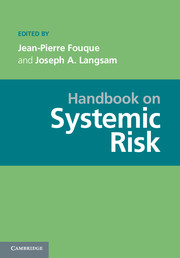Book contents
- Frontmatter
- Contents
- Contributors
- Introduction
- PART I DATA: THE PREREQUISITE FOR MANAGING SYSTEMIC RISK
- PART II STATISTICS AND SYSTEMIC RISK
- PART III MEASURING AND REGULATING SYSTEMIC RISK
- PART IV NETWORKS
- PART V SYSTEMIC RISK ANDMATHEMATICAL FINANCE
- PART VI COUNTERPARTY RISK AND SYSTEMIC RISK
- PART VII ALGORITHMIC TRADING
- PART VIII BEHAVIORAL FINANCE: THE PSYCHOLOGICAL DIMENSION OF SYSTEMIC RISK
- PART IX REGULATION
- PART X COMPUTATIONAL ISSUES AND REQUIREMENTS
- 29 Enabling Data Analysis for Addressing Systemic Risk
- 30 Operational Considerations in an Analytic Environment for Systemic Risk
- 31 Requirements for Systemic Risk Management in the Financial Sector
- PART XI ACCOUNTING ISSUES
- References
29 - Enabling Data Analysis for Addressing Systemic Risk
from PART X - COMPUTATIONAL ISSUES AND REQUIREMENTS
Published online by Cambridge University Press: 05 June 2013
- Frontmatter
- Contents
- Contributors
- Introduction
- PART I DATA: THE PREREQUISITE FOR MANAGING SYSTEMIC RISK
- PART II STATISTICS AND SYSTEMIC RISK
- PART III MEASURING AND REGULATING SYSTEMIC RISK
- PART IV NETWORKS
- PART V SYSTEMIC RISK ANDMATHEMATICAL FINANCE
- PART VI COUNTERPARTY RISK AND SYSTEMIC RISK
- PART VII ALGORITHMIC TRADING
- PART VIII BEHAVIORAL FINANCE: THE PSYCHOLOGICAL DIMENSION OF SYSTEMIC RISK
- PART IX REGULATION
- PART X COMPUTATIONAL ISSUES AND REQUIREMENTS
- 29 Enabling Data Analysis for Addressing Systemic Risk
- 30 Operational Considerations in an Analytic Environment for Systemic Risk
- 31 Requirements for Systemic Risk Management in the Financial Sector
- PART XI ACCOUNTING ISSUES
- References
Summary
Abstract Recently, the US experienced an economic crisis that shook confidence in key aspects of the financial system, and led to some calls for changes in the way the government tracks economic information that might warn of such a crisis. Among those changes was the creation of the Office of Financial Research (OFR), intended to collect and provide information to “anticipate emerging threats to financial stability or assess how shocks to one financial firm could impact the system as a whole” (OFR 2010). These functions have been termed systemic risk: the risk that a threat to a large, single component of the financial system poses to the system as a whole, due to the inter-connectedness of the system and potential lack of consumer confidence in the system that might be caused if one component failed.
This chapter considers the computational approaches that may be needed to provide information about systemic risk, and possible mitigations of that risk. We acknowledge that there are many schools of thought for why the recent crisis occurred, the degree of systemic risk it posed, and possible government actions to mitigate the risk. Our position is that an agency such as the OFR with responsibility for monitoring systemic risk must be prepared to analyze diverse, uncertain information about the financial system and threats to it. Such an agency must be prepared to evaluate this information from multiple perspectives, and assess possible future outcomes given a variety of assumptions and regulatory responses.
- Type
- Chapter
- Information
- Handbook on Systemic Risk , pp. 852 - 868Publisher: Cambridge University PressPrint publication year: 2013



